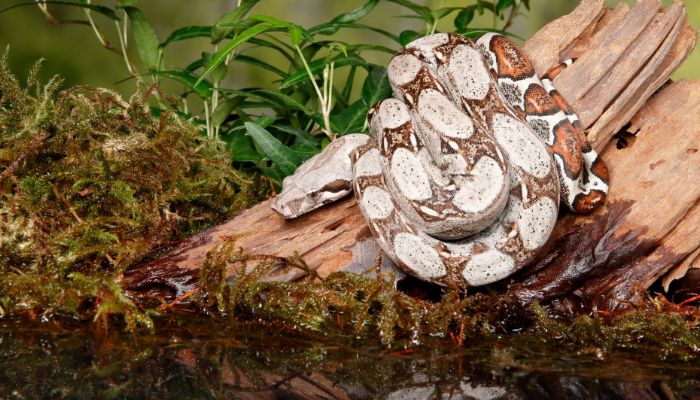Do red tail boas need UVB light? The answer is nuanced. While red tail boas can survive without UVB light, recent studies suggest that UVB exposure can offer long-term physical and mental health benefits.
Experts recommend a basking UVI of 2.0-3.0 for boas, aligning with their Ferguson Zone 2 classification. So, while not strictly necessary for survival, UVB light can contribute to a healthier, more enriched environment for your red tail boa.
We’ll delve into the science behind UVB, explore photoperiod preferences for boas, and even discuss alternative lighting options. From understanding the technical aspects of UVB bulbs to safety measures and setup tips, we’ve got it all covered.
Whether you’re a first-time boa owner or a seasoned herpetologist, this article aims to shed light (pun intended!) on all your UVB-related queries. Let’s get started!

Table of Contents
What is UVB Light?
Let’s kick things off by demystifying UVB light. UVB stands for Ultraviolet B, a type of ultraviolet radiation that’s part of the light spectrum. It’s the stuff that comes from the sun and plays a crucial role in various biological processes.
For instance, UVB helps humans produce vitamin D, which is essential for bone health. But too much of it, and you’re looking at a nasty sunburn.
In the animal kingdom, UVB light is equally important. Many reptiles, like bearded dragons and turtles, bask in natural sunlight to absorb UVB and synthesize vitamin D3. This helps them metabolize calcium, which is vital for bone structure and muscle function.
Now, you might be wondering, “What’s this got to do with my red tail boa?” Well, that’s the million-dollar question.
Do these slithering beauties need UVB light like their other reptilian cousins? The answer isn’t as straightforward as you might think, and that’s what we’re going to delve into.
Alright, that sets the stage. UVB light is more than just rays from the sun; it’s a biological necessity for many animals. But does this hold true for red tail boas? Let’s find out.
Photoperiod Preferences for Boas
Let’s talk about photoperiods, shall we? A photoperiod is basically the duration of an organism’s daily exposure to light. For red tail boas, this is a bit of a balancing act.
In the wild, they experience a natural cycle of day and night, which influences their behavior and biological functions.
Research suggests that boas prefer a 13:11 photoperiod. That’s 13 hours of light followed by 11 hours of darkness. This mimics their natural environment and helps regulate their internal clock. During winter, you can switch it up to 11 hours of daylight and 13 hours of darkness to simulate seasonal changes.
Why does this matter? Well, getting the photoperiod right can impact your boa’s overall health and well-being. It helps regulate their sleep patterns, feeding habits, and even their mood. Yes, snakes have moods too!
The Science Behind UVB and Red Tail Boas
What is Ferguson Zone 2?
First off, let’s clarify what Ferguson Zone 2 is all about. This classification is used to describe the UVB needs of various reptiles, and guess what? Red tail boas fall under this category.
This zone is for partial sun lovers or occasional baskers, much like most snakes. So, what’s the recommended basking UVI for these creatures? Experts suggest a range of 2.0-3.0.
The Importance of Basking UVI
Now, let’s break down what a basking UVI of 2.0-3.0 actually means. In simpler terms, it’s the intensity of UVB light that should be present in the basking area of your snake’s enclosure.
This is crucial because it helps you figure out the ideal distance between the UVB bulb and your snake when it’s soaking up those rays. Brands like Arcadia and Zoo Med even provide specific guidelines to take the guesswork out of it.
Challenging Traditional Wisdom
Here’s where we challenge the status quo. Most people will tell you that UVB isn’t essential for a red tail boa’s survival. While that’s technically true—your snake won’t drop dead without it—recent studies are painting a different picture.
These studies suggest that UVB exposure can offer long-term physical and mental health benefits for your snake.
Beyond Mere Survival
So, what’s the takeaway? The science is increasingly leaning towards the benefits of UVB light for red tail boas. It’s not just about scraping by; it’s about creating an environment where your pet can truly thrive. And let’s be honest, isn’t that what we all want for our animal companions?
Types of UVB Lights Suitable for Red Tail Boas
The Brands to Consider
When it comes to UVB lights, not all bulbs are created equal. Brands like Arcadia and Zoo Med are often recommended by experts for their reliability and effectiveness. These brands offer a range of UVB bulbs that are specifically designed for reptiles, including red tail boas.
The Technical Specs
Now, let’s talk specs. You’ll often see terms like T5 HO ReptiSun 5.0 or Arcadia 6% on the packaging. These numbers indicate the UVB output of the bulb. For red tail boas, you’ll want to aim for a moderate UVB output, aligning with their Ferguson Zone 2 classification.
Mesh or No Mesh?
Another thing to consider is whether your enclosure has a mesh top. Some UVB bulbs are designed to be mounted above mesh, while others work best without any obstruction. Make sure to read the guidelines to get the placement just right.
Safety Measures Related to Using UVB Lights
Distance Matters
One of the most crucial safety measures is the distance between the UVB bulb and your snake. Too close, and you risk overexposure; too far, and the UVB light becomes ineffective. Brands often provide guidelines on this, so make sure to follow them.
Regular Checks
It’s also essential to regularly check the UVB bulb for any signs of wear and tear. A faulty bulb can either emit too much or too little UVB, both of which can be harmful.
Change is Good
Lastly, remember that UVB bulbs have a lifespan. Most experts recommend changing the bulb every 12 months to ensure it’s functioning at its best.
Alternative Lighting Options
The No-UVB Camp
Let’s not forget that there’s a whole camp of people who believe that UVB lighting isn’t necessary for red tail boas. They argue that these snakes are primarily nocturnal and don’t bask in the sun in their natural habitat. So, what do they recommend?
LED and Incandescent Bulbs
Some boa owners opt for LED or incandescent bulbs to provide a light-dark cycle without the UVB. These bulbs can mimic natural daylight and are less intense than UVB bulbs. They’re also energy-efficient, which is a win-win for both you and the environment.
Heat Lamps
Heat lamps are another alternative that some owners swear by. These lamps provide the necessary warmth that red tail boas need, especially during the colder months. However, they don’t offer the UVB rays that some believe are beneficial for the snake’s overall well-being.
The Middle Ground: Timers
If you’re sitting on the fence, you might consider using a timer to control the lighting in your snake’s enclosure. This allows you to provide a natural light-dark cycle, even if you decide to skip the UVB.
How to Set Up UVB Lighting
Choosing the Right Fixture
First things first, you’ll need a suitable fixture to hold the UVB bulb. Make sure it’s the right size for the bulb you’ve chosen and that it can be securely attached to your enclosure. Some fixtures come with built-in reflectors to maximize the UVB output, which is a nice bonus.
Placement is Key
Once you’ve got your fixture, it’s time to decide where to place it. The ideal spot is usually at one end of the enclosure to create a gradient of light and heat. This allows your red tail boa to move closer or farther away from the light, depending on its needs.
Measuring the Distance
Remember, the distance between the UVB bulb and your snake is crucial. Use a tape measure to ensure you’re adhering to the guidelines provided by the bulb manufacturer. If your enclosure has a mesh top, you’ll need to adjust the distance accordingly.
Testing, Testing
Before you let your snake bask in its new light, test the setup with a UVB meter. This device measures the UVB output and ensures it’s within the safe range for your red tail boa.
Timing it Right
Lastly, set up a timer to control the light-dark cycle. This automates the process and ensures your snake gets the right amount of UVB exposure each day.
Setting up UVB lighting might seem like a daunting task, but it’s easier than you think. With the right tools and a bit of planning, you can create a well-lit, healthy environment for your red tail boa. Trust me, your slithery friend will thank you for it!
Final Word
In this article, you’ve journeyed through the complex world of UVB lighting for red tail boas. You’ve learned about the science behind UVB, the importance of photoperiods, and even explored alternative lighting options.
While UVB may not be a strict necessity for your boa’s survival, the benefits it offers for long-term health are increasingly recognized.
As a responsible pet owner, you have the power to create an environment where your red tail boa doesn’t just survive, but thrives. So go ahead, take that extra step to provide the best care possible for your slithery friend. You’ve got this!
FAQ
Do Red Tail Boas Need Light at Night?
Great question! Red tail boas are primarily nocturnal creatures, meaning they’re more active during the night. So, the short answer is no, they don’t need light at night. In fact, constant lighting can disrupt their natural sleep cycle and lead to stress.
How Much UVB Does a Boa Need?
If you’re going the UVB route, aim for a basking UVI of 2.0-3.0, as recommended for snakes in Ferguson Zone 2. The distance between the bulb and the snake is crucial, so follow the manufacturer’s guidelines to get it just right.
Will UVB Hurt Snakes?
Too much of anything can be harmful, and UVB is no exception. Overexposure to UVB can lead to skin issues and stress. That’s why it’s essential to monitor the UVB levels and follow safety guidelines.
Should I Mist My Boa Constrictor?
Misting can help maintain humidity levels in the enclosure, which is essential for your boa’s skin health. However, over-misting can lead to respiratory issues. It’s all about finding the right balance.




0 Comments